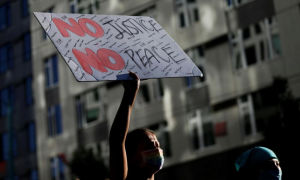[Wai Wai Nu, originally from Myanmar, is the Founder and Executive Director of the Women’s Peace Network. Grant Shubin is a Senior Legal Advisor with the Global Justice Center.]
This post forms part of the Opinio Juris Symposium on Reproductive Violence in International Law, in which diverse authors reflect on how the International Criminal Court and other jurisdictions have responded to violations of reproductive health and reproductive autonomy. The symposium complements a one-day conference to be held on 11 June 2024, in which legal practitioners, scholars, activists, and survivors will meet in The Hague and online to share knowledge and strategies for addressing reproductive violence in international criminal law. Interested readers can register to attend the conference online without cost.
Investigation after investigation (after investigation …) have detailed the 2016 and 2017 atrocities committed by Myanmar’s Security Forces against the Rohingya. Mountains of documentation all conclude that the so-called “clearance operations” were a systematic campaign of mass killing, property destruction, and especially, sexual violence.
The momentum of these investigations led to The Gambia’s case against Myanmar for perpetrating genocide against the Rohingya. Reflecting these investigations’ conclusions, The Gambia’s request for provisional measures emphasized killing, property destruction, and sexual violence–in particular rape.
These investigations and The Gambia’s case have been crucial in establishing the pattern of atrocities and criminality with respect to sexual violence and killing. So far, their narratives and conclusions have largely focused on victims’ mental and physical suffering or the material fact of their death. However, this focus has led to an obfuscation of the reproductive intent and consequences of the Security Forces’ campaign. Reproductive violence has formed an integral part of Myanmar’s genocide of the Rohingya, and any justice efforts must pay specific attention to this violence.
Genocide through Reproductive Violence
Genocidaires often fixate on target group reproduction. Reflecting this, the Genocide Convention explicitly prohibits reproductive violence, proscribing “imposing measures intended to prevent births” within the targeted group.
In Myanmar, Security Forces committed these genocidal acts in three key ways: perpetrating sexual violence; imposing legal and policy frameworks restricting reproduction; and separating the sexes.
Sexual violence
Security Forces’ sexual violence as measures intended to prevent births is seen in who, how, and where the victims were targeted.
Who: According to the UN Fact-Finding Mission on Myanmar, Rohingya women and girls of reproductive age were the “main victims” of rape, gang rape, sexually humiliating acts, and sexual mutilation (though Rohingya men, boys, elderly women, and transgender women also experienced sexual violence.)
This targeting is not by accident. In patriarchal societies like the Rohingya, women and girls are viewed as bearers of future life and keepers of community cohesion. The sexual violence deployed against Rohingya women and girls of reproductive age preyed upon these societal roles to destroy the group’s cohesion.
How: The manner of perpetration of sexual violence was extreme. The FFM’s reports describe rape, gang rape, mutilation and other injuries to reproductive organs, and branding of victims’ necks, breasts, cheeks, and thighs. Women suffered serious injuries to reproductive organs, including from rape with knives and sticks. Attacks on pregnant women were brutal and focused on harm to their pregnancies, including the kicking and stamping of stomachs, resulting in miscarriages.
Where: These attacks were frequently in public and/or in view of the victims’ family or community members. Collectively, the FFM concluded that the Rohingya have been “traumatized by their witnessing” of rape and other sexual violence committed against wives, daughters, sisters and neighbors.
In targeting Rohingya women and girls of reproductive age for brutal sexual violence perpetrated in view of their families and communities, Security Forces sought to leverage conservative and patriarchal cultural norms that emphasize – and predicate marriage and reproduction within the group upon – the sexual “purity” of female community members. The attack aimed at weakening the Rohingya’s social cohesion and ability to reproduce.
Legal Policy Framework of Limiting Reproduction
Sexual violence was committed against a backdrop of policies and laws which sought to control and limit Rohingya reproduction, including explicit restrictionson births and marriages–such as a two child limit, imposed 36-month birth spacing, and a requirement to obtain permission before marrying (a requirement that was difficult to meet for Rohingya couples who could not bride local authorities). These legislative measures to prevent or limit Rohingya births predated the mass atrocities of 2016 and 2017. Yet they laid the groundwork for the atrocities by perpetuating an inflammatory narrative alleging that high fertility rates among the Rohingya community represented an existential threat to Myanmar’s Bamar majority.
Separation of the Sexes
Security Forces further imposed measures to prevent births within the Rohingya community by murdering Rohingya men during the so-called “clearance operations,” with the effect of separating men and women.
The Krstić and Karadžić Trial Judgments noted the “procreative implications” resulting from the killing of multiple generations of Bosnian Muslims in Srebrenica. The same implications arise in Security Forces targeting of Rohingya men and boys for murder. The 2016 and 2017 operations were initially characterized by the separation of men and boys from women and girls, and the near-immediate execution of the men and boys. One witness testified to the FFMthat in Min Gyi, “soldiers separated the groups into men and women. The men were all in one group, and were killed.”
Partially as a result of this gendered extermination, some 79% of Rohingya refugees in Bangladesh are women and children. Rohingya women face tremendous challenges marrying and having children within their own community, both because of widespread sexual victimization and because of a shortage of marriageable men.
Crucially, the separation of the sexes did not begin with the 2016 so-called “clearance operations.” For decades, the Myanmar military has targeted Rohingya men for extrajudicial killings, arbitrary arrest, torture, extortion, and forced labor in addtion to depriving them of economic opportunities and employment. This has led many Rohingya men to permanently flee Myanmar, leaving their wives and daughters behind.
Reproductive Violence and Genocidal Intent
These instances of reproductive violence not only individually constitute the genocidal act of measures to prevent births, but also collectively evince the Forces’ intent to biologically destroy the Rohingya. The sexual violence campaign’s intended erosion of social cohesion, strict regulatory barriers on childbearing, and the extermination of reproductive agents within the community taken together form a pattern of conduct aimed at destroying the Rohingya’s ability to reproduce.
Conclusion
Any attempt to account for atrocities suffered by the Rohingya requires moving beyond counting bodies or cataloging injuries. It requires evaluating many other thus-far overlooked harms, including the reproductive impacts of the Security Forces’ choice and manner of violence. Only with this analysis can attempts at justice be complete.




